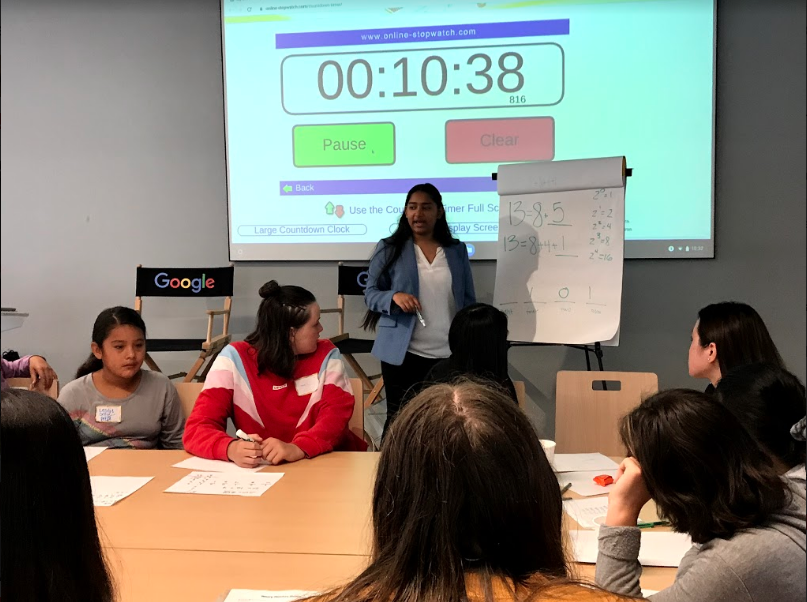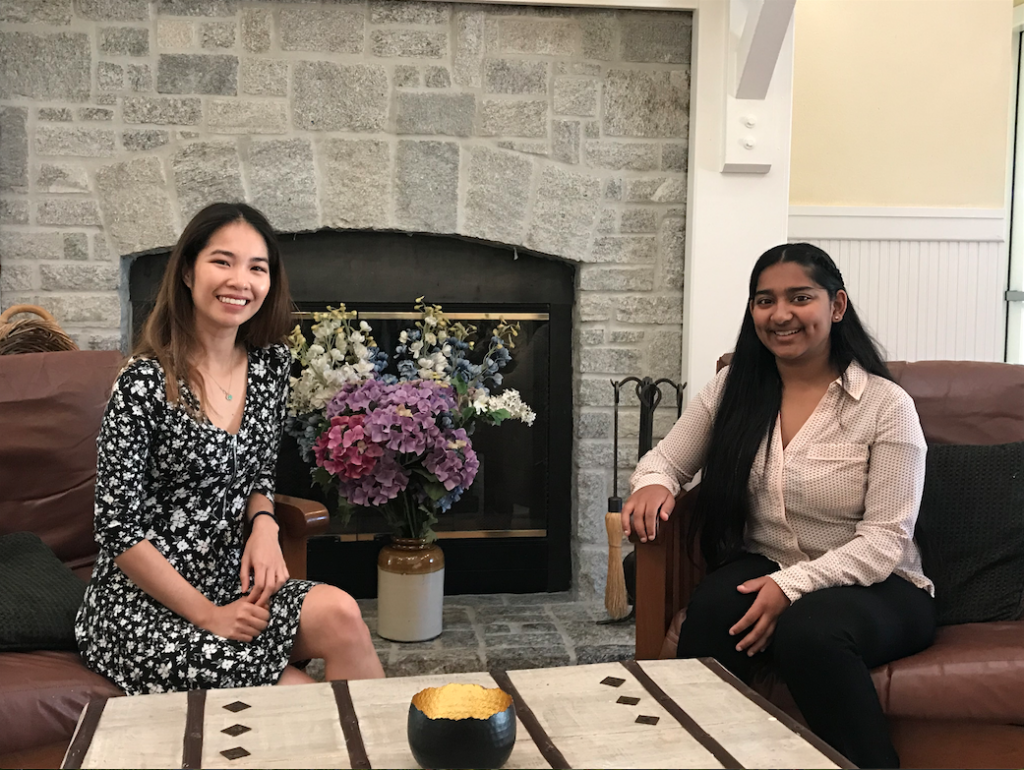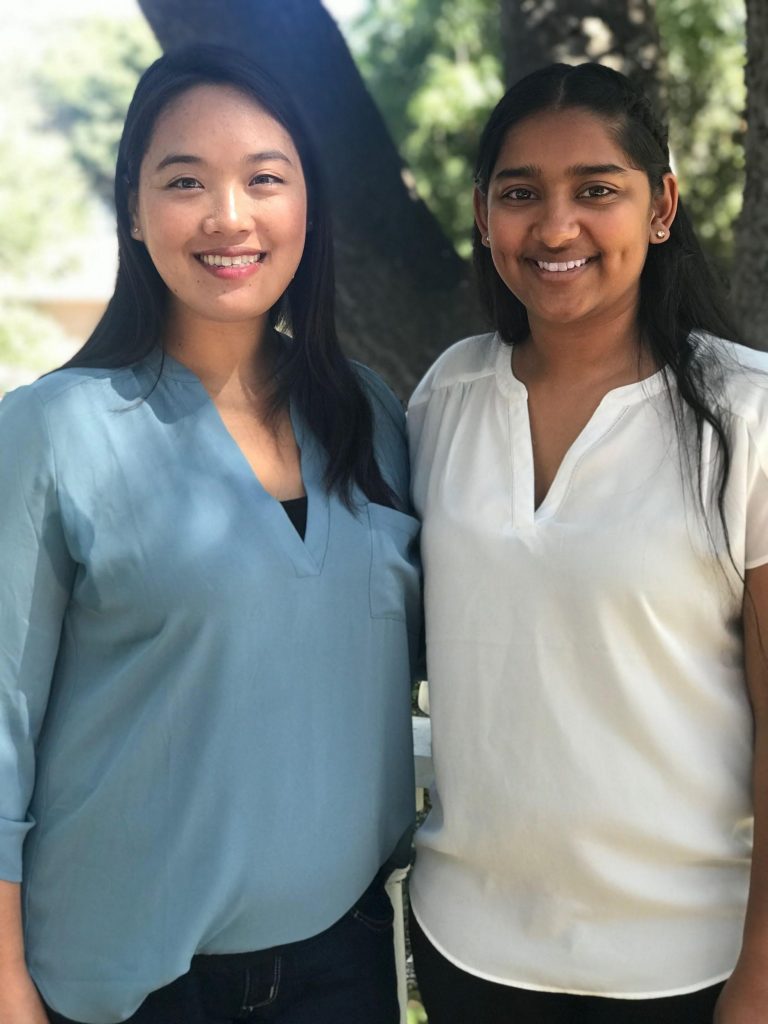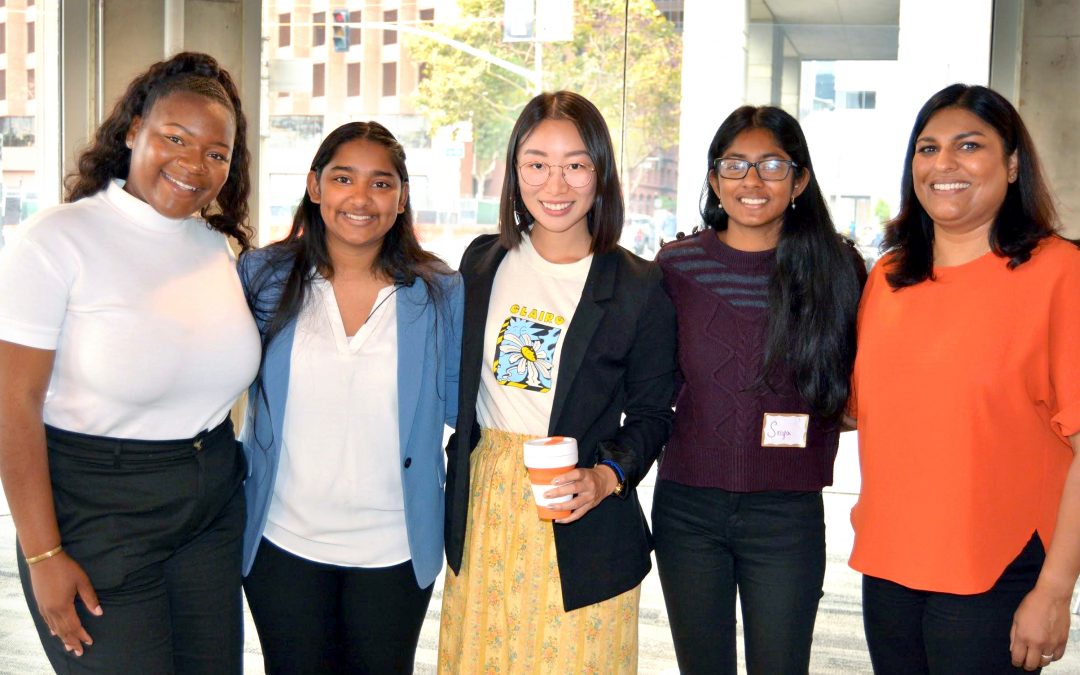When I joined Girl Scouts, I knew that I wanted to pursue my Gold Award because I wanted to give back to my community and tackle a problem. Last year, I started working on my Gold Award and created the project 1000 Bits of Hope, which gives girls inspiration and access to start their own Computer Science Journeys. I created a handful of initiatives, including a website, events, and a video series to give girls the opportunity to learn more about the tech industry and meet inspiring women role models. The journey was definitely not an easy one, but it has been a very rewarding experience! Along the way, I’ve collected my best tips for Girl Scouts interested in starting their own Gold Award!
Save it for later!
The Problem
The first and arguably most important step is choosing a specific problem you wish to solve in your community. Finding a problem that I was passionate about helped me stay committed to my project whenever I got stuck. The idea for my project came when I took a few computer science classes. I had heard of the gender disparity within the tech field, but I had never experienced it first-hand. As a result, I was appalled when I found that I was only one of a few girls in my entire class of 35 students. Living so close to Silicon Valley, I didn’t think the problem would be so severe since it is such a tech-oriented community.
I couldn’t begin to imagine what hardships and obstacles girls were facing across the country let alone around the world. Questions like “Why would girls want to pursue a field where they didn’t see anyone else who looked like them?” and “How can I do my part to help fix this problem?” instantly popped into my head. I decided to do some research and found that girls don’t pursue computer science for three main reasons: lack of confidence due to gender stereotyping, an absence of mentorship/role models, and not enough exposure at an early age. I instantly knew that I wanted to dedicate my Gold Award project to tackle this problem. I decided to create a platform where girls could meet to learn about inspirational and successful women, try out computer science activities, and come to the conclusion that the industry is for girls too!
Tip: Find a problem in your community that you are really passionate and care about because it will be your goal for the next few months to solve this problem. When you get stuck or hit a boundary, it is this problem and your passion that will keep you driven!
The Events
To start off, I hosted two events where girls could meet women in tech and participate in computer science activities. The first event was held at the Technovation World Pitch, where girls from all around the world were in attendance (including from countries like Kenya, India, Cambodia, and Canada). The second event was held at the Google Community Space in San Francisco. Over 70 girls from underrepresented areas like inner-city Oakland and San Francisco participated. Planning these events consisted of finding a venue, reaching out to possible speakers, creating activities, marketing the event for girls, and reaching out for a lot of donations.


The first step was creating an agenda for the events so that I knew what I was working towards. The events consisted of breakfast, a keynote address by Neha Palmer, Head of Energy Conservation at Google, engaging computer science activities, a panel of speakers, a raffle/giveaway, and swag bags for all! Because I was so passionate about the project, I really wanted to make sure these events would be helpful and fun for girls, and that meant making these events the best they could be!

A great way to financially support the events was through getting donations. I reached out to all of the local restaurants and coffee shops in order to provide a full breakfast for all the girls. To persuade organizations and restaurants to donate to my cause, I created a donation letter with my mission and what the specific restaurant or store could provide to help. Thanks to Noah’s Bagels, Cornerstone Bakery, Peet’s Coffee, Starbucks, Safeway, and Walmart, I was able to provide a yummy breakfast which helped the girls warm up and look forward to the rest of the event.
I also reached out to over 50 stores to get donations in the form of gift cards. I would use these gift cards to buy materials for computer science activities and giveaway items. In total, I received over $2,000 worth of product and gift cards in donations for the events from these stores! In order to stay organized and spend this money wisely, I needed to create a few spreadsheets to keep track of donation money, all the products for the events, and comparisons of product prices.
Tips: A great way to get donations is by making a donation letter. Include a letterhead, tax-ID, your mission/project, what the company/organization can donate to you, and contact information.
- Remember that all donations must be cleared by GSNorcal!
- Reach out to more companies than you actually need donations from because not all of them will follow through.
- Follow-up with these organizations on a weekly-basis. You will most likely need to remind them and call them a few times
- Send thank you notes to the organizations and stores that donated. Show them how much their donation helped you reach your goals, so that they will continue donating to girls like us! Pictures are always a nice touch.

A core part of any Gold Award project is building and leading the volunteer team. Your volunteer team helps your project run smoothly and supports you in all the different aspects of reaching your goal. Building a team turned out to be crucial to the success of my project. Leading a team also taught me a lot about leadership and grew me as a person. I learned important leadership skills, like how to communicate with people from all walks of life and how to clearly explain my thoughts and ideas.
The Girl Scout Gold Award is girl-led, but there’s no way the project can be finished alone. For example, as part of the event planning, I wanted to find women in tech who could speak at the events. I tapped into my network (including my Girl Scout network!) and reached to my contacts to see if they knew people who could be my event speakers. My contacts connected me with different women in tech, who also saw the value in the project as a way to encourage girls to pursue tech-related careers. Many of these women volunteered to help and played a major role in my Gold Award project. Since many of these women were very busy, I made sure to keep in contact with them, following up regularly on emails, and continuing to keep them engaged and excited about the events.
Tips: You will be surprised by how much you can utilize your network to help you find volunteers. A friend of a friend of a friend might just be the person you are looking for to help you with your project.
- Create a one to two paragraph statement about the problem you are trying to solve, what your solution is, and why you were inspired to do this. You can blast this message out and find people who resonate with your cause and want to help you.
- Reach out again and reconnect if you don’t get a response the first time. Be confident in yourself and your project, and try again!
5 amazing panel speakers talk about their journeys in Computer Science as women

Another important part of hosting the events was creating activities for the girls. I knew that I wanted to teach girls fundamental computer science concepts, so I brainstormed some ideas and narrowed it down to three: binary numbers, for-loops, and introductory coding in Python. Rather than just teaching these concepts, I wanted to make the activities fun so girls would enjoy the learning process and get excited about the topic. For example, when teaching how to convert numbers to the binary system, girls created bracelets with beads: one color representing 0’s the other representing 1’s. Then, their partner would guess which number they chose by looking at the bracelet. To make the for-loop station more engaging, we created grids on the floor with candy inside certain squares. Using for-loop algorithms their group had to figure out how to get all the candy from the grid with the least number of commands.
Tip: Make sure that you continue to keep your audience engaged in whatever you do! You want to make sure that you cater what you are doing to your audience’s age group and interests. Creating rewards or having interactive activities are a few ideas, but you can come up with your own as well!

Teaching students about binary numbers and creating “binary bracelets” 
Kids learn about for-loops through robots, grids, and candy
Sustainability is also a key component of a Girl Scout Gold Award. In order to continue to help girls in my community and fulfill the sustainability requirement of my project, these events will be held annually by tech organization and competition, Technovation. Making sure that my project would be sustainable was really important for me because I wanted to make sure that every year girls would get the chance to take part in these events and continue to gain exposure in the industry!
Tip: Your project must be on-going and have a lasting impact on your community! Try to partner with an organization, school, group, etc. who will take on your project once you are finished. You can also find other Girl Scouts to volunteer to take on your project.
The Video Series
In addition to hosting the events, I decided to create a video series so that no matter where girls lived or what obstacles they were facing, they could “virtually meet” women in tech! This video series is accessible to all, making meeting inspiring computer science role models something any girl can do. In each of my seven episodes, I interviewed a different woman role model (10 in total), highlighting her journey, story, obstacles, advice, career and more. The hope is that girls will learn helpful tips, hear unique stories, and envision different career options within the tech field for themselves. Creating the video series had a lot of hidden obstacles; I didn’t realize how much work went behind creating a single video!
Tip: If applicable, make your Gold Award accessible to a wider audience, where people can access it wherever they go!

Episode 2: Speaking with Sherri Douville, CEO of Medigram 
Episode 7: Talking with Ingrid Lin, Product Marketing Manager @ Google

The first step was finding women to interview. Similar to my process of finding speakers for the events, I tapped into my network and shared my story and mission. After finding ten women, I had to research each of them so that I could create questions catered uniquely to them. For example, one interviewee started out with a chemical engineering degree, so I asked how she made the switch to the tech field. Another speaker went to an all-girls high school, so we talked about how that helped her build confidence in a male-dominated field. However, I also asked some other questions, such as what their biggest piece of advice is for girls, how were they able to succeed in a male-dominated field, and what is the biggest issue women are currently facing in tech, and how we can solve that issue. It was very interesting to see how each of these women’s stories was so unique and diverse, yet they all became successful in their STEM fields!
Tip: Make sure to research and learn about important people that you are meeting with beforehand in order to have a meaningful conversation.
The biggest obstacle I faced was learning how to use all of the new equipment and technology for the videos. Since I wanted to have three camera angles, I needed to have three cameras, tripods, and microphones (and also learn how to use them!). As a result, I watched many videos to understand where the cameras should be placed, how to get the best lighting, which microphones to purchase to get the best audio, etc. Another obstacle I faced was learning how to use editing software and edit a video with multiple camera angles. Therefore, I researched the best editing software for my purposes and taught myself how to edit the footage using the Apple software iMovie. I learned how to use a b-roll while editing, and how to sync up the audio from different cameras.
Tip: You will find that when you do your Gold Award, you will learn a lot of new skills! With an open mind, you can use this as an opportunity to learn and experience new things you always wanted to try!
Website
In order to create a platform where girls could access information about the events, video series, and resources, I created the website www.1000bitsofhope.org. Especially during COVID-19, I thought this would be an important resource for girls where they could remain engaged in the content and remember to continue to pursue their dreams. Girls and adult volunteers can also join my mailing list in order to stay updated on new initiatives and projects I will be releasing! This supports the sustainability of my Gold Award, as it continues the impact of my project long after the events are over. I will continue to add more resources and videos to the website to drive web traffic and attract more girls to my mission!
Leadership
I am so thankful for this opportunity that Girl Scouts has given me. It has been a really rewarding experience and has taught me a lot about myself and new leadership skills. Throughout my journey during this project I have learned how to communicate with others, multitask, balance workloads, stay motivated, persevere, and become a leader. In order to complete this project, I needed to build a team to assist me and as a result, I was required to demonstrate leadership. This was important because although the Gold Award is girl-led, no one can complete this award without a team of supporters by their side. I led a team by training them on how to conduct and lead the computer science activities, giving guidelines to the keynote speaker for her speech, directing interviewees on the videos, and communicating with the Google Community staff on event preparation.
My Next Steps
Although my Girl Scout Gold Award project is over, I am not stopping here! I still want to continue my mission and inspire more girls to follow a career in tech. As a result, the goal is to host more events, create more videos, and provide more resources for girls to build their confidence and learn about the field of computer science. Currently, I am trying to spread the word about this Gold Award project to more girls. If you know anyone who would be interested, please don’t hesitate to share this with them!
Tip: Keep going! Even when you finish your Gold Award, try to do whatever you can to help your community.
What to Do Next
- Share https://www.1000bitsofhope.org with your community and girls who may be interested!
- Start your Gold Award today and check out more information on pre-requisites, requirements, and deadlines.
- Looking for more older girl leadership opportunities? Consider applying to be a Delegate or look into other older girl opportunities.

Suhani Singhal—Suhani Singhal is a Girl Scout Ambassador from Girl Scouts Northern California. She first got introduced to Girl Scouts through her love for backpacking at the Two Sentinels Girl Scout Camp. Ever since she joined, she has enjoyed taking up leadership positions and giving back to her community by completing her Silver and Gold Award and serving as a Regional Delegate and Girl Board Participant. During her free time, she finds herself reading, watching sci-fi movies, coding, or hanging out with friends.








